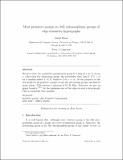Most primitive groups are full automorphism groups of edge-transitive hypergraphs
Abstract
We prove that, for a primitive permutation group G acting on a set X of size n, other than the alternating group, the probability that Aut (X,YG) = G for a random subset Y of X, tends to 1 as n → ∞. So the property of the title holds for all primitive groups except the alternating groups and finitely many others. This answers a question of M.H. Klin. Moreover, we give an upper bound n1/2+ε for the minimum size of the edges in such a hypergraph. This is essentially best possible.
Citation
Babai , L & Cameron , P J 2015 , ' Most primitive groups are full automorphism groups of edge-transitive hypergraphs ' , Journal of Algebra , vol. 421 , pp. 512-523 . https://doi.org/10.1016/j.jalgebra.2014.09.002
Publication
Journal of Algebra
Status
Peer reviewed
ISSN
0021-8693Type
Journal article
Collections
Items in the St Andrews Research Repository are protected by copyright, with all rights reserved, unless otherwise indicated.

